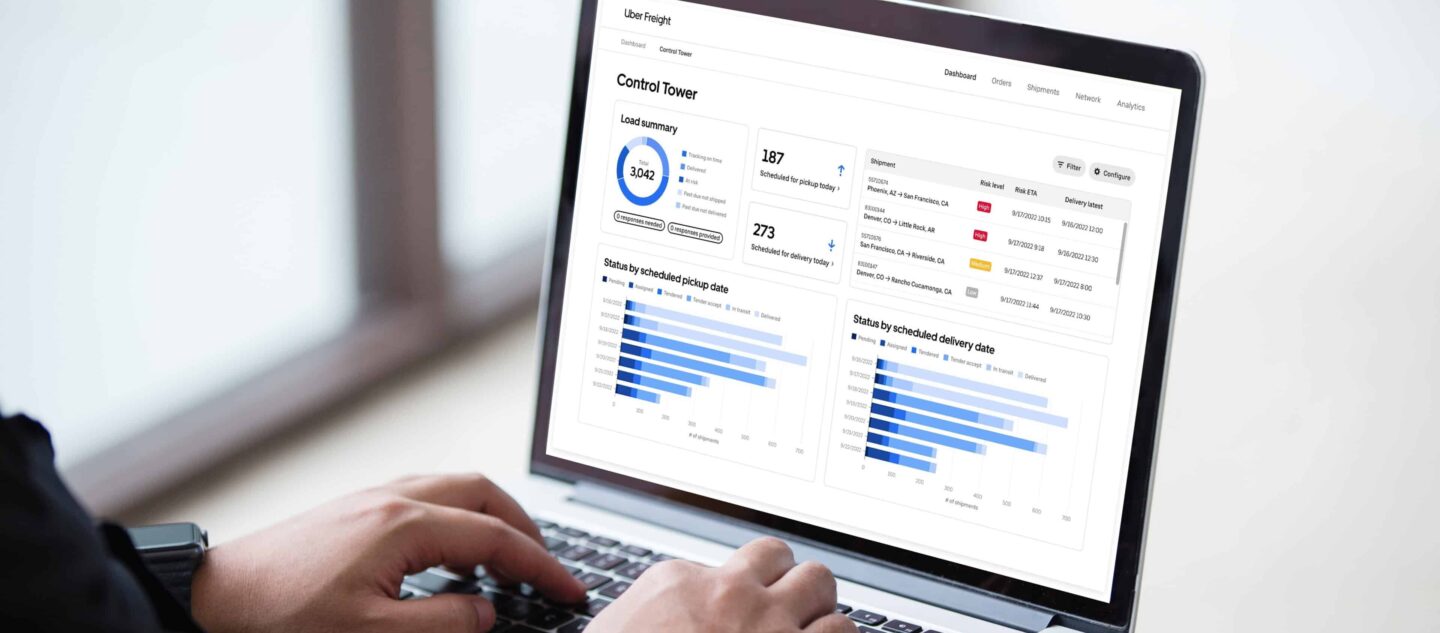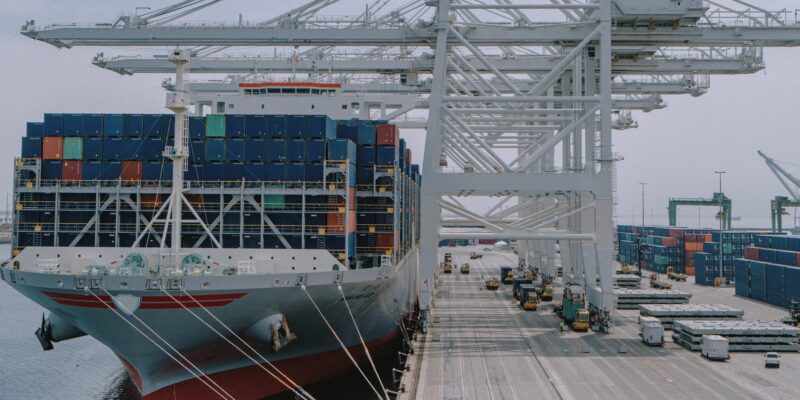A guide to transportation management systems (TMS)

At its core, a transportation management system (TMS) is a powerhouse piece of transportation management software that allows businesses to streamline and optimize their transportation operations. Often integrated with other systems like enterprise resource planning (ERP) and supply chain management (SCM), a TMS serves as the nerve center for logistics, helping companies orchestrate the seamless movement of goods and information.
Entities such as SCM play a pivotal role in TMS, ensuring the holistic optimization of the entire supply chain. ERP systems, on the other hand, contain financial and operational information, aligning business processes with TMS functionalities. A TMS brings these tools together along with real-time freight management to create business value.
Evolution of TMS: from simple tools to advanced solutions
From its humble beginnings as basic freight management tools to the sophisticated, technologically advanced solutions we see today, TMS has evolved into an essential piece of logistics operations. Technological innovation has been the driving force behind TMS evolution. TMS has embraced the cutting edge—from the adoption of artificial intelligence (AI) to harnessing the Internet of Things (IoT in logistics, to leveraging machine learning algorithms for predictive analytics. The historical journey underscores the pivotal role these advancements play in shaping the capabilities of TMS.
Core functions of a TMS system
Understanding TMS is incomplete without delving into its core functionalities. So, what are they?
From the intricacies of load planning and execution to the precision of freight tracking, payment processing, and reporting, a TMS is a multifaceted tool. This section will elaborate on the role of route optimization software, carrier management, global positioning system (GPS) tracking, and key performance indicators (KPIs) for transportation management. A deep dive into these functionalities will elucidate how they contribute to the seamless orchestration of transportation operations.
Load planning:
Load planning is a fundamental aspect of transportation management, involving the strategic organization and arrangement of goods within a shipment. TMS utilizes sophisticated algorithms to determine the most optimal way to load goods onto vehicles, taking into account factors such as weight distribution, vehicle capacity, and route optimization. This function minimizes empty spaces within vehicles, maximizing cargo capacity and reducing transportation costs. Efficient load planning also contributes to the overall reduction of carbon footprints by optimizing vehicle usage.
Execution:
TMS excels in the execution phase by automating and orchestrating the entire transportation process. It facilitates real-time communication between all stakeholders involved, such as shippers, carriers, and consignees. This automation ensures that planned routes are followed, schedules are adhered to, and any deviations or disruptions are promptly addressed. By reducing manual interventions and automating routine tasks, TMS significantly minimizes the risk of errors, leading to smoother and more reliable transportation execution.
Freight tracking:
Real-time visibility is a game-changer in the world of transportation, and TMS provides this through robust freight tracking capabilities. Advanced TMS platforms leverage technologies such as GPS and IoT to monitor the location and status of shipments in real time. This not only enhances transparency for all stakeholders, but also enables proactive decision-making in the face of unexpected events, such as delays or detours. Freight tracking is crucial for maintaining accountability, meeting delivery deadlines, and providing customers with accurate, up-to-date information on their shipments.
Payment processing:
Efficient financial transactions are integral to the smooth functioning of transportation operations. TMS facilitates seamless payment processing by automating invoicing, billing, and settlement processes. It streamlines the reconciliation of freight charges, ensuring accuracy and transparency in financial transactions between shippers and carriers. By automating payment workflows, TMS minimizes the risk of errors, disputes, and delays in the payment cycle. This not only improves cash flow for carriers but also fosters stronger, more reliable partnerships within the transportation ecosystem.
Reporting:
Data-driven insights are invaluable for making informed decisions and optimizing transportation strategies. TMS excels in generating comprehensive reports that offer deep insights into various aspects of transportation performance. KPIs related to on-time delivery, cost per mile, carrier performance, and overall supply chain efficiency are commonly tracked. These reports empower businesses to identify trends, assess the effectiveness of transportation strategies, and make data-driven decisions for continuous improvement. Moreover, reporting functionalities aid in meeting compliance requirements, providing documentation for audits, and enhancing overall accountability in the transportation process.
Strategic benefits of implementing a TMS system
The key functionalities of a TMS collectively contribute to the overall efficiency of transportation management by optimizing resource utilization, providing visibility and control, streamlining financial processes, and facilitating informed decision-making. Adopting a TMS not only improves operational efficiency but also enhances the overall reliability and competitiveness of a business in the dynamic landscape of modern logistics.
Load planning and execution functionalities minimize empty spaces in vehicles, ensuring optimal use of cargo capacity and reducing transportation costs. Freight tracking provides real-time visibility into the location and status of shipments, allowing for proactive decision-making and response to disruptions. Automated payment processing reduces the risk of errors, disputes, and delays, fostering efficient financial transactions between shippers and carriers. And reporting functionalities provide data-driven insights, enabling businesses to make informed decisions, optimize transportation strategies, and continuously improve performance.
Selecting the right TMS for your business
In the ever-evolving landscape of logistics, selecting the right transportation management system (TMS) is akin to choosing the right navigator for a complex journey. The perfect TMS can be a game-changer, aligning seamlessly with a company’s specific needs and overcoming unique logistical challenges.
Before delving into the realm of TMS options, it’s crucial to conduct a thorough analysis of your business requirements. Consider the following aspects:
- Company size: Smaller companies may require a TMS that is scalable, easy to implement, and cost-effective, while larger enterprises might need a robust, enterprise-level solution that can handle complex logistics.
- Industry dynamics: Different industries have unique logistical demands. For example, the TMS needs of a manufacturing company might differ significantly from those of a retail business. Understanding the intricacies of your industry will help tailor the TMS to your specific requirements.
- Logistical challenges: Identify the specific challenges your logistics team faces. Whether it’s optimizing routes, managing a diverse fleet, or handling complex order fulfillment processes, a TMS should address these challenges head-on.
Evaluating TMS providers
Once you have a clear understanding of your business needs, it’s time to explore TMS providers with these essential considerations:
- Vendor Reputation: Research and assess the reputation of TMS providers in the industry. Look for customer reviews, testimonials, and case studies to gauge the provider’s track record in delivering effective solutions.
- Scalability: Ensure that the chosen TMS is scalable to accommodate your business growth. A flexible system should seamlessly adapt to changes in volume, whether it’s an increase in orders or an expansion of your distribution network.
- Integration Capabilities: Check the integration capabilities of the TMS with other systems, such as your enterprise resource planning (ERP) or order management system (OMS). Smooth integration ensures a cohesive flow of information across all business processes.
Tailoring TMS to your industry
Different industries have unique requirements, and a one-size-fits-all approach may not be suitable. Consider these industry-specific factors:
- Distribution center needs: If your business relies heavily on distribution centers, choose a TMS that optimizes warehouse operations, manages inventory efficiently, and integrates seamlessly with your distribution network.
- Fleet management: For businesses with a diverse fleet, look for a TMS that excels in fleet management. This includes features such as real-time tracking, route optimization, and maintenance scheduling.
Addressing logistical challenges
Seek TMS features that directly address your specific logistical challenges:
- Route optimization: If optimizing delivery routes is a primary concern, prioritize TMS solutions with advanced route planning capabilities. This feature not only reduces transportation costs but also enhances overall efficiency.
- Order management: For businesses with complex order fulfillment processes, ensure that the TMS integrates seamlessly with your order management system (OMS). This integration streamlines the order-to-delivery process, minimizing errors and delays.
To learn more about advanced features that help shippers of all kinds leverage unprecedented insight and create proactive strategies, explore Uber Freight’s TMS.
Integration challenges and solutions
As businesses embark on the transformative journey of implementing a transportation management system (TMS), one of the inevitable hurdles they encounter is the complexity of integration. This section is dedicated to addressing common integration challenges that arise during TMS implementation and providing strategic solutions. Navigating these challenges is crucial to ensuring a seamless fusion of TMS with other essential systems.
Warehouse management systems (WMS):
Integrating TMS with WMS can be intricate, as both systems manage crucial aspects of logistics—transportation and warehouse operations. Employ middleware solutions that act as a bridge between TMS and WMS, facilitating smooth communication and data exchange. Ensure that the chosen TMS has robust compatibility with various WMS platforms.
Electronic data interchange (EDI):
EDI is a standard protocol for electronic data exchange, and ensuring compatibility with TMS can pose challenges. Choose a TMS that supports EDI standards and protocols. Additionally, leverage integration platforms that can seamlessly translate and transfer data between TMS and EDI systems, ensuring a standardized and efficient exchange of information.
Supply chain management tools:
Integrating TMS with broader supply chain management tools may require alignment of diverse data sets and processes. Opt for TMS solutions that offer pre-built connectors or APIs for popular supply chain management tools. This allows for easier integration and ensures that data flows seamlessly across the entire supply chain ecosystem.
Logistics automation:
Implementing automation in logistics, alongside TMS, demands careful synchronization to avoid bottlenecks or information silos. Leverage TMS solutions with built-in automation features or those that easily integrate with automation tools. Ensure that automated processes, such as order processing or shipment tracking, are synchronized with the TMS to maintain a cohesive and efficient workflow.
Solutions for data migration
Differences in data formats between systems can hinder smooth data migration. Implement data mapping and translation tools that can interpret information from one system into a format compatible with the other. This ensures that data retains its integrity and coherence during migration. Prioritize data cleansing activities before migration. Identify and rectify discrepancies, ensuring that the data being transferred is accurate, consistent, and aligns with the requirements of both TMS and the integrated systems.
TMS and the future of logistics
As the landscape of logistics continues to evolve, the integration of emerging technologies into TMS is reshaping the future of the industry. Artificial intelligence (AI), machine learning, and real-time visibility tools are becoming integral components of TMS, charting the course for a more sophisticated and efficient logistics ecosystem.
Artificial intelligence (AI) in transportation management
AI is revolutionizing how TMS operates, bringing about intelligent automation and decision-making capabilities. AI algorithms analyze real-time data, considering variables like traffic, weather, and road conditions to optimize delivery routes dynamically. And while AI can’t tell the future, it can help predict it: AI-driven predictive analytics forecast potential disruptions, enabling proactive measures to address issues before they impact transportation operations.
Machine learning algorithms for predictive analytics
Machine learning algorithms empower TMS with the ability to learn from data patterns, optimizing decision-making processes. Machine learning algorithms analyze historical data to optimize load planning, considering factors like delivery times, carrier performance, and cost-efficiency. TMS leveraging machine learning continuously improves accuracy in predicting shipment timelines, optimizing routes, and identifying areas for efficiency enhancement.
Real-time visibility tools
Real-time visibility tools provide instantaneous insights into the status and location of shipments. When shippers can locate shipments in real time, they can immediately identify and resolve any issues, minimizing the impact on delivery timelines. When TMS is integrated with real-time visibility tools,it enables businesses to provide customers with accurate, up-to-date information on their shipments, enhancing overall customer satisfaction.
Case studies: successful TMS implementations
TMS serves as a linchpin for businesses seeking to optimize their logistics operations. In both 3PL and 4PL, the switch to a tech-forward TMS plays a pivotal role in enhancing efficiency, reducing costs, and ultimately transforming logistics strategy. From the minutiae of operations to the big picture, Uber Freight customers know the difference a TMS can make.
As a leading national home renovation and safety company, Leaf Home needed to move away from manually managing a complex network of logistics information so that they could continue to scale. Switching to Uber Freight’s automated TMS has helped to improve delivery efficiency, reliability, and customer satisfaction, by offering real-time visibility and system routing. With Control Tower insights into the end-to-end logistics cycle, Leaf Home can now access rich data to analyze service levels, including the speed and accuracy of deliveries.
One Canadian manufacturer also received a range of tangible benefits from switching to Uber Freight’s TMS, including improved service levels, enhanced data visibility, cost savings, efficient reverse logistics, and strategic adaptability. Enhanced visibility into shipment data now enables proactive identification of delays and route adjustments, resulting in increased on-time deliveries and boosted customer satisfaction.
Conclusion: The strategic advantage of TMS in modern logistics
In the dynamic landscape of modern logistics, the role of transportation management systems (TMS) extends beyond mere operational efficiency; it becomes a strategic imperative for businesses aiming to achieve supply chain excellence. TMS serves as the linchpin in orchestrating seamless transportation operations within the broader supply chain ecosystem.
- Supply chain management: TMS integrates seamlessly with supply chain processes, optimizing the flow of goods from production to delivery.
- Transportation management logistics: TMS provides the logistical backbone, ensuring efficient planning, execution, and tracking of transportation activities.
- Sustainable transportation practices: TMS contributes to sustainability by optimizing routes, reducing empty miles, and promoting eco-friendly practices.
- Intermodal transportation systems: TMS facilitates the integration of various modes of transportation, creating a flexible and responsive intermodal network.
As the logistics landscape continues to evolve, businesses must recognize the transformative potential of TMS in ensuring supply chain resilience and excellence. TMS is a catalyst for innovation, enabling businesses to adapt to changing market dynamics, embrace sustainability, and deliver exceptional customer experiences.
Uber Freight’s TMS harnesses industry-leading technology to provide unparalleled visibility, foresight, and control. To learn more about how your logistics operations and strategy can benefit from a tech-forward TMS, request a demo today.



